Description
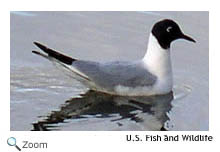 Bonaparte's gull is a small gull that is 11-15 inches in length with a wingspan of 30-31 inches. It has white undersides and breast, slate gray upperwings and back, and black tips on its wings. It has a black bill, reddish-orange legs and feet, and an orange lining on its mouth. During breeding season, it has a black face and head with
white crescents above and below its eyes. In winter, its head and face are white. Males and females look alike. Bonaparte's gull is a small gull that is 11-15 inches in length with a wingspan of 30-31 inches. It has white undersides and breast, slate gray upperwings and back, and black tips on its wings. It has a black bill, reddish-orange legs and feet, and an orange lining on its mouth. During breeding season, it has a black face and head with
white crescents above and below its eyes. In winter, its head and face are white. Males and females look alike.
Range 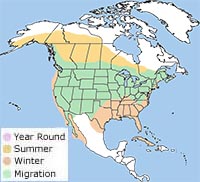 Bonaparte's gull breeds in Alaska and Canada. It winters along the Atlantic, Pacific, and Gulf Coasts and
along the Great Lakes. Bonaparte's gull breeds in Alaska and Canada. It winters along the Atlantic, Pacific, and Gulf Coasts and
along the Great Lakes.
Habitat
 Bonaparte's gull is found
near lakes, rivers, marshes and bogs near
coniferous forests during the breeding season. In the winter, it is found along lakes, rivers, marshes, bays,
estuaries, and shores. Bonaparte's gull is found
near lakes, rivers, marshes and bogs near
coniferous forests during the breeding season. In the winter, it is found along lakes, rivers, marshes, bays,
estuaries, and shores. | |
Diet
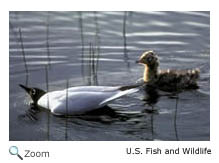 Bonaparte's gull eats
small fish, crustaceans, snails, and marine worms.
It takes its food from the surface of the water or it dives into the water to catch its prey. During breeding season, it eats insects that it catches in the air or plucks from vegetation or from the surface of the water!
Bonaparte's gull doesn't scavenge for food or eat at garbage dumps like many other species of gull. Bonaparte's gull eats
small fish, crustaceans, snails, and marine worms.
It takes its food from the surface of the water or it dives into the water to catch its prey. During breeding season, it eats insects that it catches in the air or plucks from vegetation or from the surface of the water!
Bonaparte's gull doesn't scavenge for food or eat at garbage dumps like many other species of gull.
Life Cycle
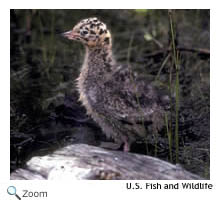 Bonaparte's gull nests in small colonies on islands or lakeshores.
The nest is cup-shaped and made with twigs, small branches, and bark. It is lined with lichen, grass, and moss and placed in a
conifer
tree. The nest is usually 4-15 feet off of the ground. The female lays 1-4 spotted green eggs and both the male and female incubate the eggs for about 24 days. Both parents care for and feed the chicks. Bonaparte's gull mates when it is two years old. Bonaparte's gull nests in small colonies on islands or lakeshores.
The nest is cup-shaped and made with twigs, small branches, and bark. It is lined with lichen, grass, and moss and placed in a
conifer
tree. The nest is usually 4-15 feet off of the ground. The female lays 1-4 spotted green eggs and both the male and female incubate the eggs for about 24 days. Both parents care for and feed the chicks. Bonaparte's gull mates when it is two years old.
Behavior
Bonaparte's gull is the only gull that nests in trees.
Bonaparte's gull is named after
French emperor
Napoleon Bonaparte's nephew, Charles Lucien Bonaparte, who was a famous ornithologist in the 1800s.
|

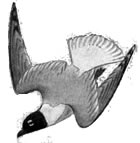

 Bonaparte's gull breeds in Alaska and Canada. It winters along the Atlantic, Pacific, and Gulf Coasts and
along the Great Lakes.
Bonaparte's gull breeds in Alaska and Canada. It winters along the Atlantic, Pacific, and Gulf Coasts and
along the Great Lakes.


